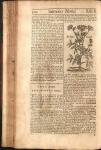
 I. The Names. It is called in Greek by Dodonaeus, *****: and in Latin, Neottia, Nidus Avis: by Gesner, it is called, Orobanche: by Lobel, Satyrium abortivum, and Orchis abortiva: but we in English call it Birds-Nest, or Goose-Nest, from the Platting of the Roots, like the sticks and straws of a Crows or Birds-Nest.
I. The Names. It is called in Greek by Dodonaeus, *****: and in Latin, Neottia, Nidus Avis: by Gesner, it is called, Orobanche: by Lobel, Satyrium abortivum, and Orchis abortiva: but we in English call it Birds-Nest, or Goose-Nest, from the Platting of the Roots, like the sticks and straws of a Crows or Birds-Nest.
II. The Kinds. Authors make two sorts thereof, the one not much differing from another, save in the color:
- the first and longest known is of a yellowish colour (Neottia nidus-avis. -Henriette.)
- the other of a purplish Violet, and is called by Clusius, Limodoron, and Pseudolimodoron. (Limodorum abortivum. -Henriette.)
 IV. The Description. Yellow Birds-Nest has a great number of Fibres or thready Roots crossing one over another, and as it were platted, or intricately entangled together like a Crows Nest: from which rises up a thick, soft, gross brown Stalk, set with small short Leaves, of the color of a dry Oaken leaf, which has laid under the Tree all Winter. Parkinson says, the Stalks are upright, weak, and sappy, and that the Leaves are only a few, being rather very short thin skins than leaves, of a brownish dead yellow color. The flowers also are of a dead yellowish color, and stand upon a spiked head, like unto that of the Orchis, and of the same fashion; after which follows Husks of dusty Seed.
IV. The Description. Yellow Birds-Nest has a great number of Fibres or thready Roots crossing one over another, and as it were platted, or intricately entangled together like a Crows Nest: from which rises up a thick, soft, gross brown Stalk, set with small short Leaves, of the color of a dry Oaken leaf, which has laid under the Tree all Winter. Parkinson says, the Stalks are upright, weak, and sappy, and that the Leaves are only a few, being rather very short thin skins than leaves, of a brownish dead yellow color. The flowers also are of a dead yellowish color, and stand upon a spiked head, like unto that of the Orchis, and of the same fashion; after which follows Husks of dusty Seed.
IV. The Purple Birds-Nest has a Root exactly like the former, from whence rise up a Stalk or Stalks about eight or nine inches high, the lower part of which within the ground is not round like the former, but slender, and of a yellowish white color: the Stalks are set with a few small, narrow, short, skinny, sharp pointed Leaves, set without any order, very little, or almost nothing at all wrapping or enclosing the Stalk, which has a spike of flowers very like the former, without Tails or Leaves growing amongst them. The whole plant, as it appears above ground, Stalks, Leaves and flowers, is of a Violet, or deep Purple color: after the flowers are fallen, there succeed Vessels full of small Seed, like the former.
V. The Places. They are both found in many places of England, in Woods, and low Copses: but they are not so much found in the Southern Parts of the Kingdom, as in the Northern: It is said, that they grow near to a Village called Knaesbrough in Yorkshire. Gerard found it growing in the middle of a Wood in Kent, two Miles from Gravesend, near to the then Mr. William Swans house of Howch-Green; the Wood then belonging to one Mr. John Sidley; the ground in the same place (says he) is covered all over with the Herb Sanicle, and with that kind of Orchis, called hermaphroditica, or butterfly Satyrion.
VI. The Times. It flourishes and flowers in June, July and August and its Seed (if it may be called Seed) which is mealy or dusty, falls in the end of August: But Gerard will not allow it to be any Seed at all.
VII. The Virtues. No Authors that have ever wrote of it, have aligned it any Virtues: however it is certain, that it is of the Nature of the Orchis, and possibly may have their Qualities, Properties, and Effects, being in like manner applied.
Botanologia, or The English Herbal, was written by William Salmon, M.D., in 1710.
This chapter has been proofread by Nick Jones.

